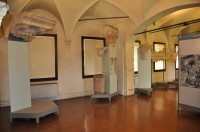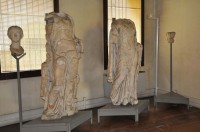The Roman Age
Mid-1st Century B.C. - Mid-5th Century A.D.
The Romanization of Veneto was a gradual process, without military intervention. Therefore, the Roman city of Vicetia, like other cities in Veneto, developed seamlessly over the existing urban core.
Following the granting of Roman citizenship to the communities of northern Italy in 49 BC, Vicenza became a municipium with its own magistrates, a territory to manage, and all the public facilities necessary for its new function.
The most important building, the theater, is still recognizable in the urban fabric, thanks to the later constructions that were erected on its ruins, preserving its layout and part of the walls.The architectural decorative elements and statues belonging to a celebratory cycle of the Julio-Claudian imperial family date the main construction phase to the central decades of the 1st century AD.
The cloister displays funerary, votive, and public inscriptions, originating primarily from Vicenza and Vicenza area, but also from Padua, Verona, and Atestine areas. The largest part of the collection is represented by the Tornieri collection, formed between the late 18th and early 19th centuries.
The large figurative mosaic from Piazza Biade, dating back to the late 4th century AD, features panels depicting heroic hunting scenes and heroes battling animals, set within a dense decorative pattern.
Image Gallery
 |
 |

